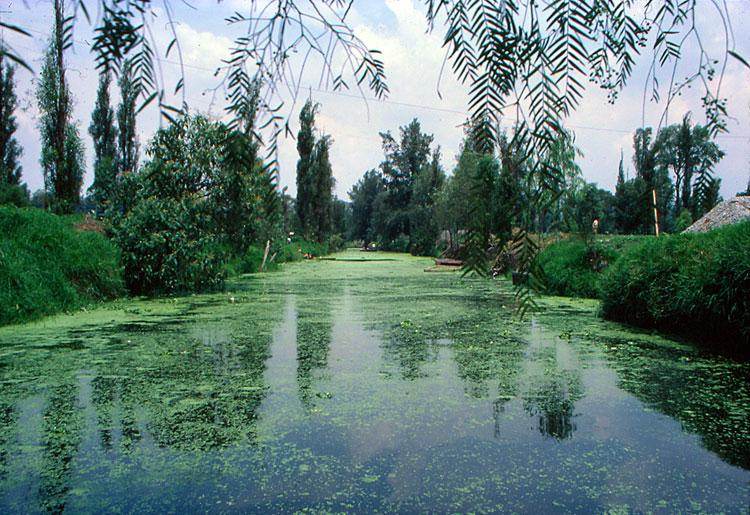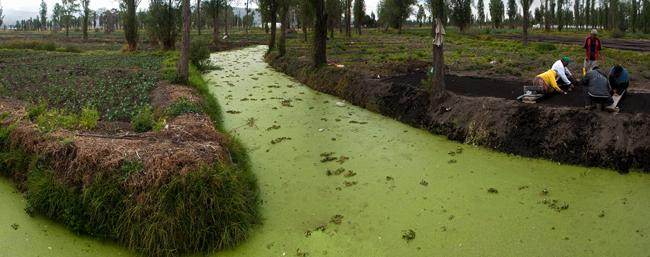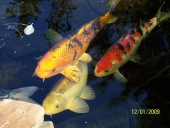




 .
.



They were created by staking out the shallow lake bed and then fencing in the rectangle with wattle. The fenced-off area was then layered with mud, lake sediment, and decaying vegetation, eventually bringing it above the level of the lake.





Idle dreamer




 . I have a firm policy against unpaid exercise. If necessary I'll put in a pump and turn it off when the space is being used for entertaining. It's going to be sort of a living room/conservatory. The indoor portion of my fish production will probably not be more than 500 ft.².
. I have a firm policy against unpaid exercise. If necessary I'll put in a pump and turn it off when the space is being used for entertaining. It's going to be sort of a living room/conservatory. The indoor portion of my fish production will probably not be more than 500 ft.². . These pipes are 15 miles long and their easement over my property is only 350 feet long and that just happens to be the spot where the giant spigot for purging is located. It's by far the most expensive item on the property. I smile every time I walk past it
. These pipes are 15 miles long and their easement over my property is only 350 feet long and that just happens to be the spot where the giant spigot for purging is located. It's by far the most expensive item on the property. I smile every time I walk past it  . I'm not allowed to tap into this but when they purge it all runs into a big ditch to a boggy area and then flows into a big culvert which runs under my driveway. Then it splashes down the side of my hill to the river 120 feet below. My place runs along the upper ridge and I don't have river frontage. I'd be crazy if I didn't suck up some of this water . I've clocked it at about 15 garbage cans per second.
. I'm not allowed to tap into this but when they purge it all runs into a big ditch to a boggy area and then flows into a big culvert which runs under my driveway. Then it splashes down the side of my hill to the river 120 feet below. My place runs along the upper ridge and I don't have river frontage. I'd be crazy if I didn't suck up some of this water . I've clocked it at about 15 garbage cans per second.





 The only noisy part is if you have a flood-and-drain bed with a bell siphon, which makes a lot of slurping and splashing sounds which some people find annoying.
The only noisy part is if you have a flood-and-drain bed with a bell siphon, which makes a lot of slurping and splashing sounds which some people find annoying.Idle dreamer








Our inability to change everything should not stop us from changing what we can.








Idle dreamer




Check out my Primal Prepper blog where I talk about permaculture, prepping, and the primal lifestyle... all the time! 




Idle dreamer
 1
1





Check out my Primal Prepper blog where I talk about permaculture, prepping, and the primal lifestyle... all the time! 
 1
1




 I hope to try again some time. I think they may need more careful acclimatization than I provided.
I hope to try again some time. I think they may need more careful acclimatization than I provided.Idle dreamer






Those who hammer their swords into plows will plow for those who don't!




Idle dreamer








 . I suppose fencing and fishing line suspended to interrupt flightpath will probably work. I'm currently building hugel beds on top of all areas of the property containing salmon berries in an attempt to replace bear habitat. I'll eventually look for a tenant who wants to raise dogs. Nothing dangerous, even little yap dogs will irritate raccoons and bears so they stay away. If I ever want bees, the hive would have to go inside some sort of bear cage.
. I suppose fencing and fishing line suspended to interrupt flightpath will probably work. I'm currently building hugel beds on top of all areas of the property containing salmon berries in an attempt to replace bear habitat. I'll eventually look for a tenant who wants to raise dogs. Nothing dangerous, even little yap dogs will irritate raccoons and bears so they stay away. If I ever want bees, the hive would have to go inside some sort of bear cage.



osker wrote:
Hmmm...I've seen temperate zone (zone 6) aquaponics in action. The key in any aquaponic system is balance, you must balance the available nutrition with the number of growing plants. If all of your plants die in cold whether then you will have to harvest all of your fish.
The system I worked with used a green house to maintain winter activity, so the outdoor portion of the water loop gets shut down in the winter (part of it reflects sunlight into the greenhouse), the fish get harvested, chickens are allowed to intermittently roost above the water to fertilize and winter greens and herbs are grown.
Check out my Primal Prepper blog where I talk about permaculture, prepping, and the primal lifestyle... all the time! 









Idle dreamer











Idle dreamer


















dale hodgins wrote:. I'll eventually look for a tenant who wants to raise dogs. Nothing dangerous, even little yap dogs will irritate raccoons and bears so they stay away. If I ever want bees, the hive would have to go inside some sort of bear cage.







.jpg)





